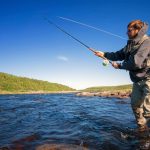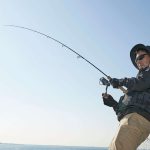Fishing is a wonderful activity for anyone looking to enjoy themselves in the great outdoors. Not only can you enjoy the sun on your back and the wind in your hair, but with a little luck, you’ll also experience the thrill of fighting and landing a real, live fish. It’s not for nothing that this activity has been popular for generations. If you’re interested in becoming an angler, you’ll have to start investing in some basic equipment.
Different Equipment For Different Types Of Fishing
It’s important to remember that fishing is a diverse activity with a wide range of possible experiences. As you can imagine, bass fishing in a small pond requires different equipment than tuna fishing on a boat in the ocean. Before making any purchases, you should consider what type of angling you’re likely to be interested in.
With that being said, certain pieces of equipment are necessary no matter what type of fishing you’re planning.
Fishing Rods
Unless you’re planning on going old fashioned like Santiago in “The Old Man In The Sea,” you’re going to need some sort of fishing rod. Most poles are made of graphite or fiberglass with a cork handle and small, circular guides for stringing the line. If you’ll be mostly freshwater fishing, then a five or six-foot rod should do the trick. Saltwater anglers prefer larger rods to catch bigger fish, with surfcasters using nine, ten, or even eleven-foot poles. Boat roads tend to be shorter and stouter, while conventional rods have the guides on the top side of the blank. Most anglers would be well advised to start out with a standard “spinning rod.” Fly fishing requires distinct equipment, none of which is mentioned here.
Fishing Reels
Just like rods, fishing reels come in a wide variety of sizes. Also, like rods, “spinning” reels represent the best option for beginners. With their spools on top and their flippable “bails,” spinning reels are easy to master and perfect for casting. They’re also ideal for a wide range of fishing activities. Other options include conventional reels and bait caster reels, which have closed, horizontal spools. While some anglers prefer these models for particular types of fishing, they’re harder to master and more prone to frustrating tangles.
Fishing Line
As you’d imagine, there’s no way to go fishing without line. There are many different types of fishing line, but “monofilament” is the ideal material for beginners. Monofilament is both strong and castable, and it doesn’t tangle as easily as some other materials. Many experienced anglers prefer braided line, which is thinner and casts farther but can quickly tie itself into impossible knots. The fluorocarbon line has the benefit of being nearly invisible underwater, but it is expensive and unnecessary for most types of fishing.
Hooks
If you’re planning to fish with bait (live or dead fish/worms), then you’re going to need hooks. The size of the hook will depend on the species of fish that you’re planning to target. You need a hook that’s strong enough to hold, but small enough to fit in the fish’s mouth.
Weights And/Or Bobbers
Most types of fishing require a weight or bobber, both for lengthening your cast and keeping the bait where you want it in the water column. For most types of fishing, you’re better off using a weight to bring the bait to the bottom of the pond, lake, river, or ocean. Fish like to feed among plants and rocks while avoiding open water where they feel vulnerable to predators. That’s why you want your bait on the bottom. Most weights are made of lead, and they need to match the size of your rod. Casting a heavy weight with a lightweight rod is an easy way to break your new purchase. Bobbers or floats are suitable for certain types of fishing, like when you want to drift your bait through a large, open area. They’re also great for kids, who get a thrill out of watching the bobber disappear when you get a bite.
Lures
While fishing with bait is often the best for maximizing your chances of success, lures are also popular among anglers who enjoy staying busy. Bait is typically tossed out and left alone until you feel a bit, but most lures need to be cast and retrieved to be effective. The size and appearance of the lure depend on the type of fishing you’re doing. Most lures attempt to mimic a popular food source for fish in the area.





